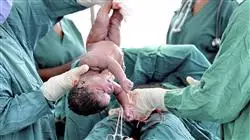University certificate
The world's largest faculty of nursing”
Introduction to the Program
You will have the ability to choose where, when and how to take on the entire course load thanks to the great freedom and flexibility that TECH gives you"

As various advances are made in the field of obstetric emergency delivery and postpartum care, there is more evidence of a low-intervention practical approach, minimizing the rate of iatrogenesis. It is key in this context that the nurses have updated admission criteria, as well as protocols for action against the pathologies that may occur during childbirth.
Therefore, this TECH Postgraduate diploma presents a scientific and clinical content updated to the reality of the obstetric emergency department. The nurses will find broad topics where to deepen the analgesia during the period of dilation, labor dystocia, uterine atony, puerperal infection and many more issues of special interest and topical in the field of obstetric emergencies in childbirth and postpartum.
All this with the guarantee of having a completely online qualification.All this with the guarantee and convenience of a completely online format. TECH Global University has eliminated both face-to-face classes and fixed schedules, resulting in greater flexibility and convenience for the students. The didactic contents are available in their entirety for download from any device with an Internet connection, being able to study them from the smartphone, tablet or computer of your choice.
Incorporate into your daily practice the most important advances in cardiac and endocrine alterations in the postpartum period, as well as birth canal trauma and methods for monitoring fetal well-being"
This Postgraduate diploma in Obstetric Emergencies in Delivery and Postpartum for Nursing contains the most complete and up-to-date scientific program on the market. The most important features include:
- The development of case studies presented by experts in Obstetric and Neonatal Emergencies
- The graphic, schematic, and practical contents with which they are created, provide scientific and practical information on the disciplines that are essential for professional practice
- Practical exercises where the self-assessment process can be carried out to improve learning
- Its special emphasis on innovative methodologies
- Theoretical lessons, questions to the expert, debate forums on controversial topics, and individual reflection assignments
- Content that is accessible from any fixed or portable device with an Internet connection
The teaching team has been chosen for their clinical and academic merits, guaranteeing you the in-depth knowledge you need in the field of Obstetric Emergencies"
The program’s teaching staff includes professionals from the industry who contribute their work experience to this program, as well as renowned specialists from leading societies and prestigious universities.
The multimedia content, developed with the latest educational technology, will provide the professional with situated and contextual learning, i.e., a simulated environment that will provide immersive education programmed to learn in real situations.
This program is designed around Problem-Based Learning, whereby the professional must try to solve the different professional practice situations that arise during the academic year For this purpose, the students will be assisted by an innovative interactive video system created by renowned and experienced experts.
The quality of the contents is guaranteed, as they combine the most recent scientific postulates with the clinical practice of the entire teaching team"

Update yourself with 3 extensive and exhaustive modules on Obstetric Emergencies in the dilatation phase, expulsion phase, delivery and postpartum"
Why study at TECH?
TECH is the world’s largest online university. With an impressive catalog of more than 14,000 university programs available in 11 languages, it is positioned as a leader in employability, with a 99% job placement rate. In addition, it relies on an enormous faculty of more than 6,000 professors of the highest international renown.

Study at the world's largest online university and guarantee your professional success. The future starts at TECH”
The world’s best online university according to FORBES
The prestigious Forbes magazine, specialized in business and finance, has highlighted TECH as “the world's best online university” This is what they have recently stated in an article in their digital edition in which they echo the success story of this institution, “thanks to the academic offer it provides, the selection of its teaching staff, and an innovative learning method aimed at educating the professionals of the future”
A revolutionary study method, a cutting-edge faculty and a practical focus: the key to TECH's success.
The most complete study plans on the university scene
TECH offers the most complete study plans on the university scene, with syllabuses that cover fundamental concepts and, at the same time, the main scientific advances in their specific scientific areas. In addition, these programs are continuously being updated to guarantee students the academic vanguard and the most in-demand professional skills. In this way, the university's qualifications provide its graduates with a significant advantage to propel their careers to success.
TECH offers the most comprehensive and intensive study plans on the current university scene.
A world-class teaching staff
TECH's teaching staff is made up of more than 6,000 professors with the highest international recognition. Professors, researchers and top executives of multinational companies, including Isaiah Covington, performance coach of the Boston Celtics; Magda Romanska, principal investigator at Harvard MetaLAB; Ignacio Wistumba, chairman of the department of translational molecular pathology at MD Anderson Cancer Center; and D.W. Pine, creative director of TIME magazine, among others.
Internationally renowned experts, specialized in different branches of Health, Technology, Communication and Business, form part of the TECH faculty.
A unique learning method
TECH is the first university to use Relearning in all its programs. It is the best online learning methodology, accredited with international teaching quality certifications, provided by prestigious educational agencies. In addition, this disruptive educational model is complemented with the “Case Method”, thereby setting up a unique online teaching strategy. Innovative teaching resources are also implemented, including detailed videos, infographics and interactive summaries.
TECH combines Relearning and the Case Method in all its university programs to guarantee excellent theoretical and practical learning, studying whenever and wherever you want.
The world's largest online university
TECH is the world’s largest online university. We are the largest educational institution, with the best and widest online educational catalog, one hundred percent online and covering the vast majority of areas of knowledge. We offer a large selection of our own degrees and accredited online undergraduate and postgraduate degrees. In total, more than 14,000 university degrees, in eleven different languages, make us the largest educational largest in the world.
TECH has the world's most extensive catalog of academic and official programs, available in more than 11 languages.
Google Premier Partner
The American technology giant has awarded TECH the Google Google Premier Partner badge. This award, which is only available to 3% of the world's companies, highlights the efficient, flexible and tailored experience that this university provides to students. The recognition as a Google Premier Partner not only accredits the maximum rigor, performance and investment in TECH's digital infrastructures, but also places this university as one of the world's leading technology companies.
Google has positioned TECH in the top 3% of the world's most important technology companies by awarding it its Google Premier Partner badge.
The official online university of the NBA
TECH is the official online university of the NBA. Thanks to our agreement with the biggest league in basketball, we offer our students exclusive university programs, as well as a wide variety of educational resources focused on the business of the league and other areas of the sports industry. Each program is made up of a uniquely designed syllabus and features exceptional guest hosts: professionals with a distinguished sports background who will offer their expertise on the most relevant topics.
TECH has been selected by the NBA, the world's top basketball league, as its official online university.
The top-rated university by its students
Students have positioned TECH as the world's top-rated university on the main review websites, with a highest rating of 4.9 out of 5, obtained from more than 1,000 reviews. These results consolidate TECH as the benchmark university institution at an international level, reflecting the excellence and positive impact of its educational model.” reflecting the excellence and positive impact of its educational model.”
TECH is the world’s top-rated university by its students.
Leaders in employability
TECH has managed to become the leading university in employability. 99% of its students obtain jobs in the academic field they have studied, within one year of completing any of the university's programs. A similar number achieve immediate career enhancement. All this thanks to a study methodology that bases its effectiveness on the acquisition of practical skills, which are absolutely necessary for professional development.
99% of TECH graduates find a job within a year of completing their studies.
Postgraduate Diploma in Obstetric Emergencies in Delivery and Postpartum for Nursing.
Labor and delivery and postpartum emergencies are medical situations that can occur during the process of pregnancy, delivery and after delivery. These situations can be life-threatening emergencies that require immediate medical attention. Examples of labor and postpartum emergencies include postpartum hemorrhage, placental abruption, hypertension, infections, cesarean section complications, and fetal distress.
For nursing professionals, it is essential to be trained to detect and treat these situations in a timely manner. This nursing program focuses on the management of obstetric and neonatal emergencies.
Students will develop skills on the signs and symptoms of labor and postpartum emergencies, and on the procedures and treatments necessary to address them. They are also trained in the importance of communication and interprofessional collaboration in emergency situations to ensure the best care and outcomes for mother and baby.
It is important for nursing professionals working in obstetrics to stay current on the latest research and medical advances in the field of obstetrics. They must also have the ability to adapt quickly to changes in the health care environment and new technologies available.
Adequate training and education are essential for nursing professionals to effectively and safely identify, assess, and treat obstetric and neonatal emergencies. The goal of the program is to provide students with a thorough understanding of the obstetric emergencies described and the appropriate way to act and provide nursing care. Students will learn how to identify and manage obstetric emergencies at all stages of obstetric care, from delivery to postpartum. Specific protocols and procedures used in these situations will be taught, which may include neonatal resuscitation techniques, administration of medications, and care of the newborn and their mothers after delivery.







